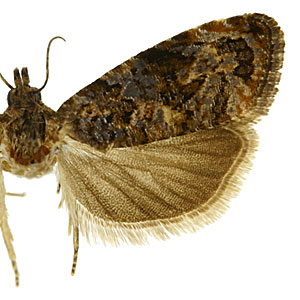Adult Recognition

FWL: 4.5-8.5 mm
Fresh specimens have a bluish-gray cast to the forewings with varying orange-brown scaling. Three gray spots edged with black are present near the termen. Worn specimens may be difficult to distinguish from similar species without a genitalic dissection. Males lack a forewing costal fold.
Some species of Paralobesia species resemble E. hebesana in wing coloration and pattern. Worn specimens of E. hebesana may resemble a variety of North American olethreutines, and a genitalic dissection may be necessary to confirm identity.
Larval Morphology

Late instar larvae are approximately 10 mm in length. The abdomen varies in color, but many individuals are yellowish or reddish with inconspicuous pinacula. The head and prothoracic shield are black. An anal comb is present with 4-6 teeth.
Larvae are morphologically similar to those of Lobesia and Paralobesia, including Lobesia botrana and Paralobesia viteana. The D2 setae on A9 are on a joined "saddle" pinaculum, the D1 and SD1 setae on A9 are on a single pinaculum, and the SV group on A7 is trisetose (SV counts 3:3:3:2:2). However, it unlikely that larvae of E. hebesana would be encountered on the same hosts as L. botrana or P. viteana.
Biology

Larvae develop in the seeds of their host plants. Adults are present in mid-April through September, many times in large numbers. Multiple generations are produced in southern locations.
Host plants
Larvae of this species have been recorded feeding on members of at least eight plant families. In some areas it is considered a minor pest of ornamentals.
| Family | Genus/species | Common name |
| Anacardiaceae | Toxicodendron diversilobum (Torr. & A. Gray) Greene | Pacific poison oak |
| Asteraceae | Solidago L. | goldenrod |
| Betulaceae | Ostrya Scop. | hophornbeam |
| Gentianaceae | Frasera caroliniensis Walter | American columbo |
| Gentianaceae | Gentiana saponaria L. | harvestbells |
| Gentianaceae | Gentianopsis crinita (Froel.) Ma | greater fringed gentian |
| Iridaceae | Iris L. | iris |
| Iridaceae | Tigridia Juss. | peacock flower |
| Lamiaceae | Physostegia Benth. | lionsheart |
| Lamiaceae | Physostegia virginiana (L.) Benth. | obedient plant |
| Lamiaceae | Scutellaria L. | skullcap |
| Lamiaceae | Scutellaria lateriflora L. | blue skullcap |
| Lamiaceae | Stachys L. | hedgenettle |
| Lamiaceae | Teucrium canadense L. | Canada germander |
| Ranunculaceae | Delphinium L. | larkspur |
| Sarraceniaceae | Sarracenia L. | pitcherplant |
| Sarraceniaceae | Sarracenia purpurea L. | purple pitcherplant |
| Scrophulariaceae | Antirrhinum L. | snapdragon |
| Scrophulariaceae | Aureolaria flava (L.) Farw. | smooth yellow false foxglove |
| Scrophulariaceae | Aureolaria Raf. | false foxglove |
| Scrophulariaceae | Castilleja affinis Hook. & Arn. | coast Indian paintbrush |
| Scrophulariaceae | Castilleja affinis Hook. & Arn. ssp. affinis | coast Indian paintbrush |
| Scrophulariaceae | Castilleja latifolia Hook. & Arn. | Monterey Indian paintbrush |
| Scrophulariaceae | Castilleja Mutis ex L. f. | Indian paintbrush |
| Scrophulariaceae | Orthocarpus Nutt. | owl's-clover |
| Scrophulariaceae | Pedicularis canadensis L. | Canadian lousewort |
| Scrophulariaceae | Penstemon Schmidel | beardtongue |
| Scrophulariaceae | Verbascum L. | mullein |
| Verbenaceae | Verbena L. | vervain |
Distribution

Endothenia hebesana is present in eastern North America, Texas, and the Pacific coast. It is also recorded from China, Finland, Japan, Norway, and Russia.
References

Gilligan, T. M., D. J. Wright and L. D. Gibson. 2008. Olethreutine moths of the midwestern United States, an identification guide. Ohio Biological Survey, Columbus, Ohio. 334 pp.
MacKay, M. R. 1959. Larvae of the North American Olethreutidae (Lepidoptera). Canadian Entomologist Supplement 10: 1-338.
Miller, W. E. 1983. Nearctic Endothenia species: a new synonymy, a misidentification, and a revised status (Lepidoptera: Tortricidae). Great Lakes Entomologist. 16: 5-12.




